Margaret Cobleigh recently attended an SCA embroidery workshop on Opus Anglicanum, a form of medieval embroidery associated with England (though extant examples of the style can also be found on the continent). I’m a great fan of Margaret’s work – you’ve seen many examples of it on Needle ‘n Thread if you’ve been around for a bit. The strawberry tea cloth, for example, is hers, as is the goldwork rose. Incidentally, so is the design for the pomegranate I recently finished as a wedding gift for my niece. This design will be featured in January’s Inspirations Magazine, and I’m really looking forward to seeing it in print. Needless to say, I was thrilled when she sent photos of her class project from the Opus Anglicanum workshop. With her permission, I’ll share those here.
Opus Anglicanum is a style of embroidery that’s easily recognizable. The embroidered figures are worked in split stitch, in silk, and are often surrounded by backgrounds of gold, worked in a technique called undersided couching.
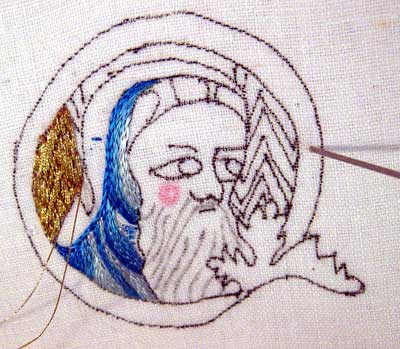
Here, you can see the beginnings of the piece. The thread Margaret used is Soie Platte from Kreinik, a thread which has been discontinued. The gold is Japanese gold #2 or Benton & Johnson’s 341. Notice the zig-zag lines behind the figure – that’s where the thread will be couched, in order to create a design and texture in the gold.
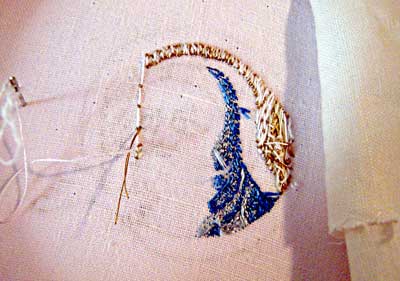
Brave woman! She sent a photo of the back of the work!! This is to show the undersided couching – you can see the little dots of gold coming through the back. The way undersided couching works is this: you take your couching thread up to the front of the fabric, pass over the gold, and go back down into the fabric in the same hole you can out of. Then you give a little tug and pop the gold to the back of the work. This forms a ridge in the gold, and it makes the goldwork backgrounds less stiff, which was important for the work during that era, since much of it was done on items of clothing, particularly ecclesiastical vestments.
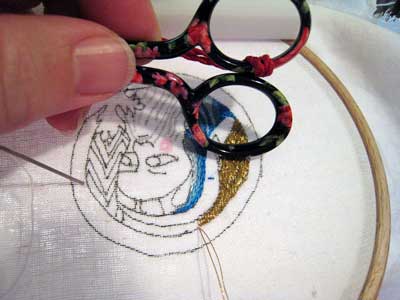
Margaret said the instructor taught them to take their scissor handles and rub the gold after stitching it, to relax it so that it lays better and fills in well. This is one reason I think it must be great to go to workshops with good teachers – those little tricks you wouldn’t necessarily learn from a book! Margaret really praised the SCA instructors…. and it made me (ok, I admit it!!) a bit greeeeen with envy! I’d love to take one of these workshops! They just sound fun!
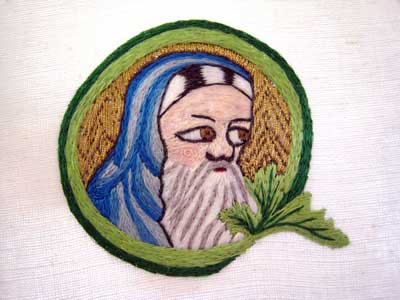
Here’s the finished little fellow. This picture shows off the gold background design well – you can see the ridges from the undersided couching quite clearly.
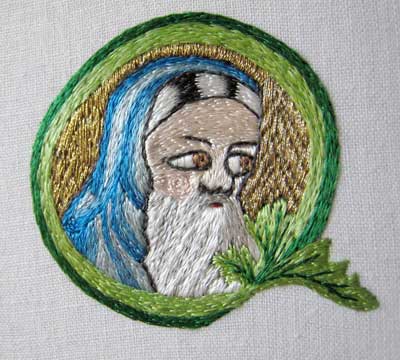
And in this photo, you get a good view of the sheen on the silk. Nice!! You can also see the circular stitching on the cheeks – also typical of this style of embroidery – and, of course, there are those bulbous eyes that really crack me up. The exaggerated eyes were also typical of the technique.
I’ve read a little bit on Opus Anglicanum, and I’ve had the pleasure of briefly perusing A.G. Christie’s book on English Medieval Embroidery, but not enough to say anything with any certitude on the development of the “look” of Opus Anglicanum. I would imagine that the look of the eyes and facial elements came about two ways (and I’m well open to correction on this!): 1. I think the figures mimic a bit the icons prevalent at the time; and 2. because the figures were worked on ecclesiastical garb (which would be viewed from afar), it would make sense that certain aspects of the figures would be exaggerated so that they could be seen from a distance. Just a shot in the dark…. anyone?
Anyway, I thought you would enjoy seeing these photos of this technique! Thanks, Margaret, for sending them along!
Guess what I just added to my list of “Things I Want to Play With if I Could Just Find the Time”? Right – Opus Anglicanum!
And just a note – Don’t forget to sign up for this week’s book give-away, if you haven’t already. The book is Heirloom Embroidery, and it’s a good one!







Hi,
What is SCA? Just curious!
Thanks!
The SCA is the Society for Creative Anachronisms – it’s kind of an historical “re-enactment” sort of group. I’m not involved or associated with the organization at all, but they do have many members dedicated to keeping alive arts from the past, specifically, I think, from the Middle Ages and Renaissance. So they research and practice different types of historical arts and crafts, like embroidery, illumination, woodworking, etc. You can find information about the organization online, if you google it.
This is on my list to try, too. But I have to finish Phase X first and I think I have found my next icon, plus, I have to do a gift for my Bible Study teacher. Not to mention 2 Christmas outfits and a 1 year old heirloom birthday dress. Whew! Anneg
Nice writeup Mary–thanks!
I just want to add that I am not an SCA member, but they allowed non-members to participate in the symposium. The classes were held in Southern California, but I think they may hold next year’s gathering in Northern California. I had four classes in two days. They were well-organised, the teachers were very knowledgeable, and we had a lot of fun! I would urge anyone interested to attend and, no, they didn’t make the non-members wear costumes although we could if we wanted. 🙂
Margaret does beautiful work. I’m lucky enough to see it in person as well as online!
Wow Margaret, beautiful work. I only heard of underside couching recently and have been keen to try it ever since. May I ask what is your background fabric? It looks like linen but what count did you use and also what did you use for couching thread, it looks quite thick?
CA
Wow! This stitching is great… It is so beautiful 🙂 I’d like to try something like that one day…
CA:
The fabric is linen (2 pieces in fact), but I don’t know the count. Being a surface embroiderer, I’m woefully ignorant about fabric counts. To me it’s just a garden variety of linen, but not super dense.
The couching thread that came in the kit was something used for making lace I believe. I never did find out for sure what it was. I ran out midway through the piece and finished with some Gutterman’s upholstery thread which was almost exactly the same size and worked just fine.
Do try this technique. It really isn’t terribly difficult. I’m looking forward to trying some more.
I also attended the SCA symposium and I agree with Margaret on the quality and subject of the classes. The projects were small enough to introduce you to technique and the instructors were outstanding. I consider myself a fair-to-middling needleworker and I was able to pick up the techniques easily.
The couching was fun. Another thing about using the scissors handles and rubbing the gold: It also burnishes it and you get a nice soft reflective effect.
Mary, I think your reason #2 about the motifs being designed to be viewed from afar is correct. Even today most ecclesiastical garmets have outsized motifs or elements within the motifs.
Right now, I’m working toward being a licensed pastor and I’m trying to talk Margaret into making me a stole. I think an Opus Anglicanum stole would be lovely, don’t you? :}
Thanks for the great work you’ve done with this blog. It’s a treat!
I’m a long time member of the SCA, and I’ve had the privilage of attending numerous classes throughout the past 25 years I’ve been a member. Several have been needle art classes, and even a couple on Opus Anglicanum. I am also well versed in all aspects of the calligraphy and illumination of the same time period as that of Opus Anglicanum. The cartoons or line drawings for this technique were taken directly from the illuminations found in the religious manuscripts of the time period. The scribes who drew the pictures for the illuminations were the same people who drew the cartoons used for this form of needlework. The cartoons or drawings for the needlework would not have been something a secular person, such as a housewife, would do. The lines of stitching closely reflect the lines, brushstrokes, and shading techniques used in the manuscript illuminations. They were generally not meant to be viewed from a distance by the masses, but close up by individuals. The over-sized eyes are the same as found in all manuscript illuminations of the same time period and style of illumination. The needlework technique is believed to have originated in England, then spread throughout Western Europe. However, documents from the time period tell us English needleworkers remained the true masters of this technique.
Hope this helps a little.
Lori Northon
Hi Opus Anglicanum, was not “associated” with England, it was conceived and exclusively originated in England, and executed solely by English embroiderers. Continental European attempts were absolutely nowhere near the quality or artistry of Opus Anglicanum.
I really love the look of this. I tend to use split stitch quite often as a filling stitch. I had no idea that it was used in this was, historically. I always worry that people will look at my work and wonder what I am thinking ;). I just really love the look of it and it feel natural to me.
It’s easier to control and looks neater than satin stitch for larger areas, just my opinion of course. I’m working on a memorial piece now using quite a bit of this stitch. I just adore historical work.
I really enjoyed reading this.